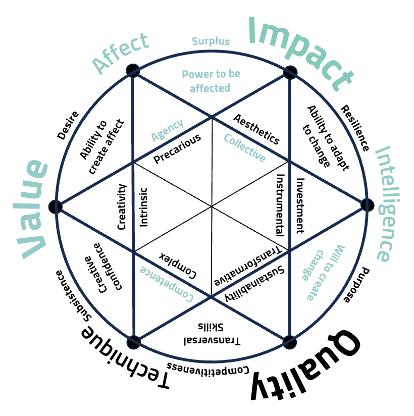
It is evident that the greenhouse gases emitted by activities in the cultural and creative sectors and industries contribute in different degrees to the overall environmental impact that causes the current climate emergencies. This impact arises from diverse activities such as production processes, transportation, energy consumption, and the use of materials that have significant carbon footprints.
To comprehensively evaluate the multifaceted impact of creative activities, cultural programmes, or artistic initiatives, it is paramount to acknowledge, comprehend, and emulate not only the direct and immediate, but also the indirect consequences and effects that are engendered by both audiences and participants. While indirect impact may not be immediately discernible or apparent, it can substantially contribute to long-term outcomes.
Key considerations in addressing this challenge include spill-over effects, behavioural change, knowledge transfer, economic impact and social influence. By systematically identifying and analysing these indirect impacts, deeper insights can be gained into the full extent of the footprint generated by visitors to major cultural events or activities.
While it is currently feasible to measure the footprint of the programmed components of an event, it remains challenging to identify, measure, let alone mitigate, the carbon emissions created through audience participation.
However, the measurement of participants’ footprints can only be achieved through research conducted by the participants themselves. Similarly, the transformation of participants’ behaviours can only be achieved through their own actions and in their own responsibility. Ultimately, system-level change requires a collective will to create change that arises from co-research, co-agency, and co-ownership of the entire process of change.
This challenge is about empowering participants, visitors, audiences and spectators to assume the role of co-researchers rather than being perceived as mere objects of research and investigation. Instead of eliciting negative emotions such as guilt and the sacrifice of pleasure, this challenge aims to encourage and promote meaningful participation and playful co-creation. As a result, it increases participants' capacity for action and creates tangible change.
Specific challenges for PACESETTERS main target groups:
- For artists and creatives: Developing tools and frameworks to stimulate the agency of audiences as co-researchers who investigate the indirect impact of cultural activities
- For research: Sharing established methods for registering the surplus generated and measuring its impact while investigating the required levels of cultural competence
- For policymakers: Uptake of results and highlighting of their unique competitiveness which stems from both the power to be affected and the will to create change
- For finance and investment: Recognising the value of audience driven and scientific research and incentivising their combination as a form of collective intelligence.
